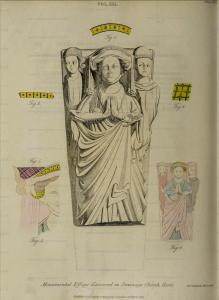Archaeologia Volume 21 Section XXXII
Archaeologia Volume 21 Section XXXII is in Archaeologia Volume 21.
Account of a Monumental Effigy discovered in Stevenage Church [Map] in Hertfordshire: By Mr. Robert T. Stothard (age 29), addressed to the Right Honourable the Earl of Aberdeen (age 42), K. T. President. Read 16th March 1826.
Robert Thomas Stothard: In 1797 he was born to Thomas Stothard and Rebecca Watkins.

75, Great Titchfield Street, March 8, 1826.
My Lord
The accompanying Drawing (PI. XXII.), which I beg leave to exhibit to your Lordship and the Society, was made in the autumn of 1824, from an Effigy then lately discovered in the church of Stevenage in the county of Hertford.
The costume is evidently of Edward the First’s time, and with the exception of the feet, the figure is as perfect as could be expected, after having been with its face downwards (for centuries perhaps) doomed to supply the place of a step in the south-side aisle of that Church.
The bandelet, which passes over the fore part of the head-dress, is beautifully carved, representing jewels of precious stones, emblazoned with gold, red, and blue, with a small border of black; as in fig. 1.
The Tissue, which confines all the hair except the front locks, is of a gold ground, with squares of green, ornamented with white and red, as in fig. 2.
Fig. 3, represents the pattern of the Girdle or Band round the waist.
Fig. 4, the Strings of the Mantilla, which are attached to the girdle, and prevents that garb from dropping off the shoulders.
Fig. 5, represents part of the Head-dress in its colours, and the ornamented Pillow.
Fig. 6, the Effigy as it appears to the eye.
The care and attention with which the sculptor carved the attendants upon this Effigy, induces me to believe them to be the figures of her children; for they are much larger than those upon other monuments of its own time, before or since. Those of other monumental effigies are represented supporting the crest, as in Aymer de Valence’s; burning incense, as in John’s; and generally, as in these, they are represented with wings, as angels; but those in the Effigy at Stevenage bear evident marks of uncommon attention being paid to distinguish them from others. And I am induced to believe also, that the one on the left with the cowl, represents John de Stevenage, a cellarer of St. Alban’s Monastery, from the 27th to the 31st of Edward the First, 1298 to 1302, a descendant of the original founder of the Abbey of Stevenage. The Village of Stevenage derived its name from a monastery which formerly stood near or on the site of the present church, about half a mile from the road. Chauncy says, the Abbot of Stevenage held it of the gift of Edward the Confessor, and claimed very large liberties by the grants of the said King, and the grants of William the Conqueror, Henry the First, and Richard the First, which upon a quo warranto therein allowed,a and the Abbot thereof did continually enjoy it until the dissolution of the great Monasteries.
I made this Drawing, as I thought the object of it too interesting to remain any longer unnoticed.
I have the honour to be,
My Lord,
Your Lordship’s
obedient servant,
ROBERT T. STOTHARD.
To the Earl of Aberdeen, &c, &c. &c.
Note a. Vide Chauncy.